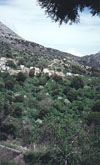

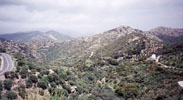
From the Dorian site of Lato, we went back to the coast road at Agios Nikolai and turned back toward Hersonnisos. At Napoli, we again went inland, up a steep hairpinning road to a little village with a great view back over the sea, and then into more rolling country. Before long the road again became more rugged. At the time, I wrote: "the road is amazing--narrow hairpins, up and up, passing little villages with ever more spectacular views." My pictures don't reflect this very well, but here anyway are three views from the road up to the plateau.
 |
 |
 |
| Three views of scenery on the road up to the Plateau of Lassithi, which is at 900m (3,000 ft) above sea level. Click on any of them to see a larger version. | ||
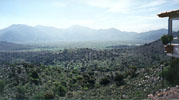 |
| First view of the Plateau of Lassithi in the distance below. We eventually left the plateau through the pass you see near the right side in the distance. |
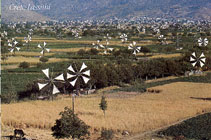 |
The plateau itself is a surprising place. After climbing the mountains on these roads, sometimes at only 20-30 kph because of the nature of the road, often a bit scary, you come to a little roadside stop...with a view. Such a view! The Plateau of Lassithi is laid out flat, far below. Again, as so often, it is hard to do the scene justice with a simple photograph.
The plateau is ringed all around by mountains, some of them snow-capped at that season. It is hard to be sure, but the plateau itself must be some 200 m below the lowest point of the ring wall. Clearly, from its absolute flatness, it must once have been a lake bed, but one wonders where the water went (and where it came from--the climate must have been a good deal cooler and wetter then).
In contrast to much of Crete, the Plateau of Lassithi is a fertile, fruit-growing area. It is irrigated mostly by electric pumps pumping groundwater, but at one time the pumps were operated by windmills, and some still are. The plain is littered with the metal skeletons of 17th century windmills. Apparently, they are operated on a windmill festival day, as is shown in this picture, taken from a postcard.
 |
 |
 |
In many places, both in Mainland Greece and on Crete, there are little roadside shrines in the form of a church. Our guide on the Greek bus tour, Poupie, said that these are erected where there has been an accident, but not necessarily a fatality. Some are indeed put there in remembrance of someone who dies, but some are placed in thanks for the fact that someone survived the accident. The one in the picture is much more elaborate than most. It is a pretty close replica of the real church behind it, unfortunately hidden by the tree in the picture.
The metal-frame windmills are not the only windmills on the Plateau of Lassithi. Some of them are much bigger and stronger, stone towers mounted on the edge of the mountain ring facing the wind up the slope. As we were climbing the road up to the exit pass, we could see the line of towers stretching up the hills both sides of the road. I wanted to stop and take a picture, but the only parking place was by a junk-food stand, and it was fairly crowded, so we didn't stop, which was a pity. However, here is a postcard picture of a few of the stone windmills. We were later to see another such array of windmills in Santorini, again on a ridge where there must be a strong prevailing wind in a constant direction.
As we were driving up the road to the rim, what we didn't realize was that on the other side of the rim there was an almost sheer cliff down to the plain some 800m (2500 ft) below, which the road hugs as it drops. As soon as we passed the ridge, we saw this breathtaking view. There is only a chain-link fence to prevent one from driving over the edge, which wouldn't be hard to do at night, it is so unexpected. And shortly after I took this picture, we drove for a few moments through the bottom of the cloud bank, which isn't the finest feeling on such a road! Going down is even more spectacular than the drive up from Napoli, but it is short. One is soon down to the rolling country, and quickly back to Hersonnisou.
Once back in Hersonnisos, we returned the rented car, bought a small bottle of retsina, and repaired back to our little patio overlooking the sea, before packing to leave Crete.
This was our last day in Crete. The travel agency that had been supposed to take us from the airport to Hersonissos arranged for us to be taken back to Heraklion for the evening ferry to Santorini. However, we asked instead that we be taken to Heraklion in the morning so that we could explore the town. The taxi arrived at 9:00, and we stored our baggage in their office while we looked around the town. Walking the sometimes narrow streets, we felt that Heraklion was even more infested by motor-bikes than Hersonissos, though perhaps not as badly as Athens!
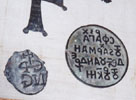 |
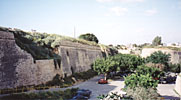 |
First, we left a note for the Norths at their hotel, with a list of the symbols we found at Phaestos and Malia, after which we went to the Historical Museum, which covers the period from the Byzantine Empire to the Second World War. The museum is interesting, but not very big. A lot of it covers the fighting between the Venetians and the Turks for dominion over Crete. It took the Turks a 22 year siege of Heraklion in the 17th century before the Venetians finally decided the struggle was no longer worth the continued effort. Another large segment of the museum covers the hundred years of the Greek fight for independence from Turkey. Even after Crete attained independence from Turkey, it was not allowed to join Greece for several years after a referendum in favour of "Enosis" succeeded. And there are many pictures of the Nazi invasion and occupation in the 1940s.
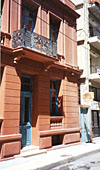 |
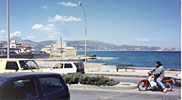 |
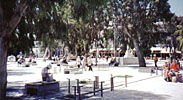 |
| Views of Heraklion. (Left) a typical Venetian house, (Middle) the sea front, from outside the Historical Museum, with one of the many motorbikes. (Right) The central square, surrounded by shops and cafes. A pleasant place to eat a sandwich! | ||
From the Historical Museum, we walked into the centre. There is a big modern marble-floored central public square with shade trees, good for a picnic lunch, along with many small streets with old "Venetian" buildings. Next we went to the Archaeological Musem, where we noted some of the "Minoan hieroglyphics," many of which look the same as our Mason's Marks. Quite a few of their examples were from Knossos, and there were many we did not have. But on the other hand, we collected quite a few that were not on their "list of the Mason's Marks." I tried to photograph some of the Linear A and B tablets, but flash was not permitted, and the pictures did not come out. In the museum, we once again ran into the Norths! They had already seen the note we had left at their hotel.
After that, we just walked until a bit after 6pm, when we returned to the LeGrand travel agency office. We explored the market that extends over two or three streets, and I bought a wallet for 2000dr (about $8), which I now use regularly. We explored a bit of the city wall, much of which still exists. The Turks never were able to breach it during their siege, and it is still quite impressive.
From the LeGrand office, we took a taxi to the ferry terminal. We were told that the fare should be about 500dr, but the driver charged 1500dr. We couldn't argue, not having firm evidence of the cheat, and paid what was asked. But it left a final bad taste after a pleasant stay in Crete.
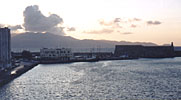 |
| Heraklion harbour. Sunset over the hills, from the deck of the ferry to Santorini. |
The ferry was a standard big car ferry. It didn't leave until about sunset, but we were on it early, and snagged a small table under a roof on an aft deck near the bar. We bought a couple of small bottles of wine, and used them to wash down our sandwiches.
The ferry had an interesting way of making PA announcements. They turned on loud music just before making each announcement, and kept it on during the announcement to ensure that nobody could hear what was being said. Other than that, the ferry and its service were fine. The night got a bit cold, but it was still interesting to watch when we approached Santorini in the pitch black night, as the lights of the towns high on the cliffs got closer and closer. We couldn't see the land itself, so the lights began to look like clouds of stars high above us.